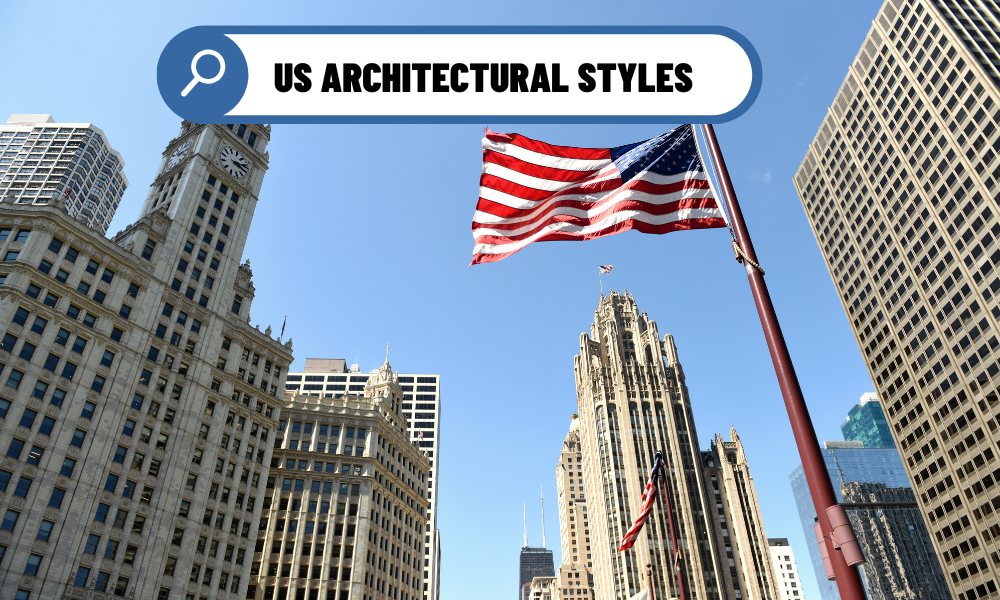The architecture of the United States tells a story of cultural evolution, blending practicality with aesthetic expression across centuries. Shaped by immigration, technological advancements, and regional landscapes, American architectural styles reflect the nation’s dynamic history. This article explores the essence of these styles, focusing on their character and significance.
Colonial Era: Roots of Functionality
In the colonial period, settlers brought European building traditions to America, crafting homes designed for survival. English settlers in New England built sturdy, symmetrical structures with steep roofs to shed snow, using timber and brick. Dutch influences in the Hudson Valley introduced gambrel roofs, while Spanish settlers in the Southwest used adobe and tiled roofs suited to arid climates. These homes were practical, their designs shaped by local materials and weather, embodying a rugged yet purposeful beauty.
Georgian and Federal: Classical Aspirations
After independence, American architecture embraced refinement through Georgian and Federal styles, inspired by Greek and Roman ideals. Homes and public buildings featured balanced facades, delicate moldings, and decorative flourishes like fanlights. Built primarily in brick, these structures reflected the young nation’s desire to project sophistication and order, signaling a cultural shift toward a distinct American identity.
Victorian Era: Eclectic Exuberance
The Victorian era, fueled by the Industrial Revolution, brought a wave of ornate and eclectic designs. Mass-produced ornaments enabled architects to experiment freely, turning homes into expressions of individuality. Urban rowhouses adopted Italianate elegance, while rural estates embraced the romanticism of Gothic Revival. With intricate woodwork and vibrant colors, Victorian architecture celebrated personal creativity and technological progress.

Craftsman Movement: Simplicity and Craft
Reacting to Victorian excess, the early 20th century’s Craftsman movement championed simplicity and harmony with nature. Homes featured low profiles, exposed wood, and wide porches that invited outdoor living. Handcrafted details and built-in furniture emphasized quality over extravagance. Affordable and functional, these designs resonated with the middle class, particularly in the West and Midwest, where natural landscapes inspired their earthy aesthetic.
Modern and Mid-Century Modern: Minimalist Innovation
The mid-20th century ushered in modernism, defined by minimalism and new materials like glass, steel, and concrete. Mid-Century Modern homes, with sleek lines and expansive windows, captured post-war optimism, blending open interiors with outdoor spaces. These designs prioritized efficiency and environmental connection, reflecting a society eager to embrace innovation and a forward-looking lifestyle.
Postmodern and Contemporary: Playful and Sustainable
Recent decades have seen architecture diversify. Postmodernism rejected modernist restraint, introducing playful shapes and historical references with bold creativity. Contemporary designs, meanwhile, prioritize sustainability, integrating eco-friendly materials and smart technology. Green roofs and energy-efficient systems balance aesthetic appeal with environmental responsibility, addressing modern challenges with forward-thinking solutions.
Regional Influences: Geography and Identity
American architecture varies by region, shaped by climate and culture. The Northeast retains colonial brick homes built for harsh winters. Southern architecture, from grand plantation houses to Spanish-inspired courtyards, suits warm climates. The Midwest’s Prairie School mirrors flat horizons with horizontal lines, while the West’s modern homes merge indoor comfort with sprawling landscapes, reflecting a deep connection to place.
Conclusion: A Living Legacy
American architecture is a living narrative, each style a chapter in the nation’s story. From the practical simplicity of colonial homes to the eco-conscious designs of today, these buildings reveal how Americans have balanced utility, beauty, and identity. As the country evolves, its architecture will continue to adapt, honoring its diverse past while embracing new possibilities.
